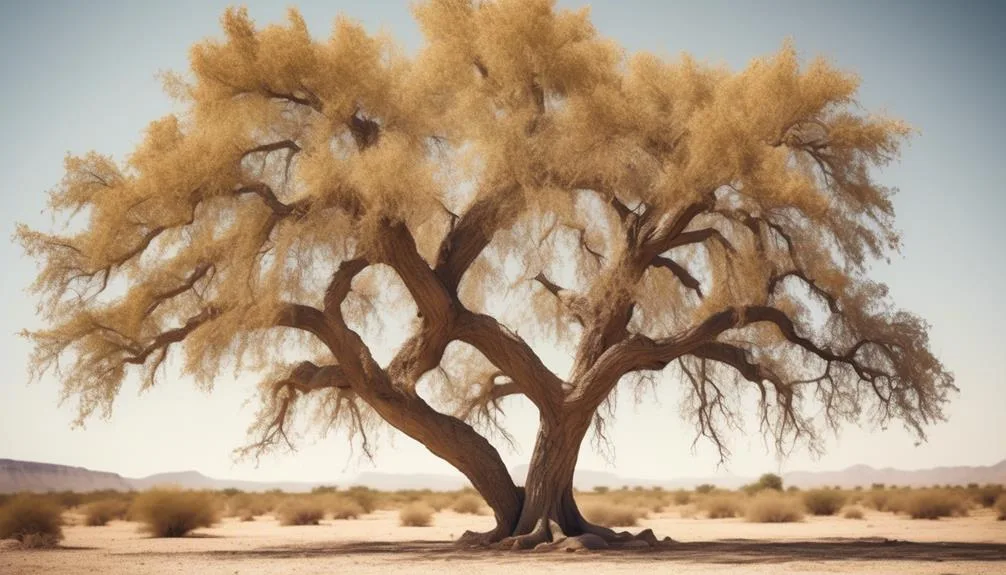Elm trees have a reputation for being tough in the face of drought. But just how resilient are they? Understanding the factors that make elm trees able to withstand dry spells can provide valuable insights.
It's fascinating to explore the reasons behind their ability to endure harsh conditions. By learning more about this, you can gain a deeper understanding of how to care for these remarkable trees during challenging times.
Elm Trees and Drought Resistance
Elm trees possess remarkable natural mechanisms for surviving periods of drought, making them a fascinating subject for understanding how certain tree species adapt to challenging environmental conditions.
Their ability to thrive in drought conditions is attributed to their efficient water conservation strategies. Elm trees have evolved to have deep and extensive root systems, allowing them to access water sources that aren't available to other tree species. This enables them to withstand prolonged periods of dry weather without experiencing significant stress.
Furthermore, their suitability for withstanding drought makes them an ideal choice for landscaping in areas prone to water scarcity. Understanding the mechanisms that allow elm trees to thrive in drought can provide valuable insights for developing strategies to conserve water and select tree species that are well-suited to challenging environmental conditions.
Factors Affecting Elm Tree Drought Tolerance
Understanding the key factors that contribute to the drought tolerance of elm trees is essential for effectively managing and preserving these resilient species in challenging environmental conditions.
Water conservation plays a crucial role in the drought tolerance of elm trees. During dry periods, elm trees have the ability to regulate their water usage, conserving moisture to withstand prolonged periods of drought.
Additionally, soil moisture is a significant factor affecting elm tree drought tolerance. Elm trees thrive in well-drained soils, and their ability to access moisture from deep within the soil contributes to their resilience in drought conditions.
Understanding the intricate relationship between water conservation and soil moisture is vital for promoting the drought tolerance of elm trees and ensuring their survival in the face of challenging environmental circumstances.
Strategies for Helping Elm Trees Survive Drought
Adapting watering practices and implementing mulching techniques can significantly enhance the drought resistance of elm trees. When it comes to water conservation, consider using drip irrigation or soaker hoses to deliver water directly to the tree's root zone, minimizing evaporation. This helps maintain adequate soil moisture levels during dry periods.
Additionally, applying a layer of organic mulch around the base of the tree can reduce water evaporation from the soil and regulate soil temperature, promoting better water retention.
Best Elm Tree Varieties for Drought Conditions
When selecting elm tree varieties for drought conditions, consider their inherent resilience and adaptability to arid environments. Some of the best drought-tolerant elm species include the Lacebark elm (Ulmus parvifolia), Cedar elm (Ulmus crassifolia), and the Frontier elm (Ulmus 'Frontier'). These varieties have demonstrated the ability to withstand prolonged periods of dryness without compromising their health.
When cultivating these elms in drought-prone areas, it's crucial to implement effective watering techniques. Deep, infrequent watering encourages the trees to develop deep root systems, which enhances their ability to access water during dry spells. Additionally, applying a layer of mulch around the base of the tree can help conserve soil moisture.
Maintaining Elm Trees During Drought Periods
To maintain elm trees during drought periods, it's essential to prioritize deep, infrequent watering and the application of mulch to conserve soil moisture around their base. Here are some techniques to help you effectively maintain your elm trees during drought:
- Watering techniques: Water deeply and less frequently to encourage the tree's roots to grow deeper into the soil, making them more resilient to drought conditions.
- Soil management: Apply a layer of mulch around the base of the tree to help retain soil moisture and regulate soil temperature. This will also reduce water evaporation from the soil.
- Monitoring: Keep a close eye on the tree for any signs of stress such as wilting or yellowing leaves, and adjust your watering schedule accordingly.
Conclusion
In caring for your elm trees during drought, selecting the right variety is essential. Providing proper care and water is also crucial. Additionally, implementing strategies to help them withstand dry conditions is necessary. By following these steps, you can ensure the strength and health of your elm trees, regardless of challenging weather.
Consider these tips and witness your elm trees thrive, resilient against whatever nature presents.

My interest in trees started when I first saw the giant sequoias in Yosemite.
I was a teenager then, and I remember thinking, “I need to learn more about this.”
That moment stuck with me.
A few years later, I went on to study forestry at Michigan Tech.
Since graduating, I’ve worked in a mix of hands-on tree care and community education.
I’ve spent over ten years helping people understand how to plant, maintain, and protect the trees in their neighborhoods.
I don’t see trees as just part of the landscape.
They are living things that make a real difference in our daily lives.
